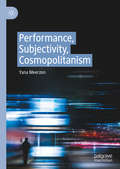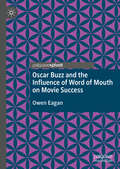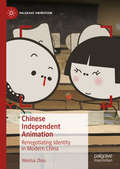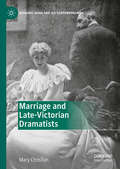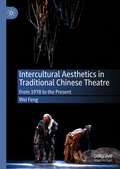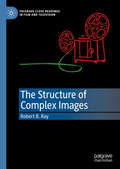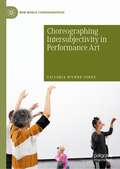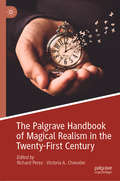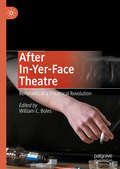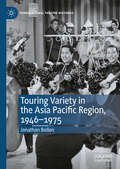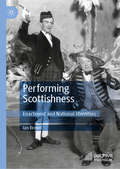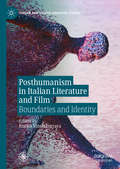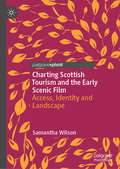- Table View
- List View
Contemporary African Dance Theatre: Phenomenology, Whiteness, and the Gaze (New World Choreographies)
by Sabine SörgelThis book is the first to consider contemporary African dance theatre aesthetics in the context of phenomenology, whiteness, and the gaze. Rather than a discussion of African dance per se, the author challenges hegemonic perceptions of contemporary African dance theatre to interrogate the extent to which white supremacy and privilege weave through capitalist necropolitics and determine our perception of contemporary African dance theatre today. Multiple aesthetic strategies are discussed throughout the book to account for the affective experience of ‘un-suturing’ that touches white spectatorship and colonial guilt at their core. The critical analysis covers a broad range of dance choreography by artists from the Democratic Republic of Congo, Ivory Coast, South Africa, Canada, Europe, and the US as they travel, create, and show their works internationally to global audiences to contest racial divides and white supremacist politics.
Performance, Subjectivity, Cosmopolitanism
by Yana MeerzonThis book looks at the connection between contemporary theatre practices and cosmopolitanism, a philosophical condition of social behaviour based on our responsibility, respect, and healthy curiosity to the other. Advocating for cosmopolitanism has become a necessity in a world defined by global wars, mass migration, and rise of nationalism. Using empathy, affect, and telling personal stories of displacement through embodied encounter between the actor and their audience, performance arts can serve as a training ground for this social behavior. In the centre of this encounter is a new cosmopolitan: a person of divided origins and cultural heritage, someone who speaks many languages and claims different countries as their place of belonging. The book examines how European and North American theatres stage this divided subjectivity: both from within, the way we tell stories about ourselves to others, and from without, through the stories the others tell about us.
Oscar Buzz and the Influence of Word of Mouth on Movie Success
by Owen EaganThis book explores why word of mouth is the most important determinant of a movie’s success. Beginning with a discussion of the enduring appeal of movies, and why the box office has survived the disruption of television and will likely survive the disruption of streaming services, Owen Eagan goes on to discuss the unpredictable nature of movies and ways to mitigate their risk. His astute analysis sheds light on the role of film festivals, film critics, Oscar campaigns, and word of mouth in influencing a film's success. Eagan concludes with a summary of why word of mouth is the most influential among all the variables that affect a film’s outcome. Expertly synthesizing quantitative analyses of box office data with illuminating insights from industry experts, this concise and engaging book presents findings with important implications for scholars, industry insiders and marketing professionals alike.
Danish Television Drama: Global Lessons from a Small Nation (Palgrave European Film and Media Studies)
by Anne Marit Waade Eva Novrup Redvall Pia Majbritt JensenThis book explores how to understand the international appeal of Danish television drama and Nordic Noir in the 2010s. Focusing on production and distribution as well as the series and their reception, the chapters analyse how this small nation production culture was suddenly regarded as an example of best practice in the international television industries, and how the distribution and branding of particular series – such as Forbrydelsen/The Killing, Borgen and Bron/The Bridge – led to dedicated audiences around the world. Discussing issues such as cultural proximity, transnationalism and glocalisation, the chapters investigate the complex interplays between the national and international in the television industries and the global lessons learned from the way in which screen ideas, production frameworks and public service content from Denmark suddenly managed to travel widely. The book builds on extensive empirical material and case studies conducted as part of the transnational research project ‘What Makes Danish Television Drama Travel?’
Chinese Independent Animation: Renegotiating Identity in Modern China (Palgrave Animation)
by Wenhai ZhouThis study of ‘independent’ animation opens up a quietly subversive and vibrant dimension of contemporary Chinese culture which, hitherto, has not received as much attention as dissident art or political activism. Scholarly interest in Chinese animation has increased over the last decade, with attention paid to the conventional media circle of production, distribution and consumption. The ‘independent’ sector has been largely ignored however, until now. By focusing on distinctive independent artists like Pisan and Lei Lei, and situating their work within the present day media ecology, the author examines the relationship between the genre and the sociocultural transformation of contemporary China. Animation, the author argues, has a special significance, as the nature of the animation text is itself multilayered and given to multiple interpretations and avenues of engagement. Through an examination of the affordances of this ‘independent’ media entity, the author explores how this multifaceted cultural form reveals ambiguities that parallel contradictions in art and society. In so doing, independent animation provides a convenient ‘mirror’ for examining how recent social upheavals have been negotiated, and how certain practitioners have found effective ways for discussing the post-Socialist reality within the current political configuration.
Labor and Aesthetics in European Contemporary Dance: Dancing Precarity
by Annelies Van AsscheThis transdisciplinary study scientifically reports the way the established contemporary dance sector in Europe operates from a micro-perspective. It provides a dance scholarly and sociological interpretation of its mechanisms by coupling qualitative data (interview material, observations, logbooks, and dance performances) to theoretical insights. The book uncovers the sometimes contradicting mechanisms related to the precarious project-oriented labor and art market that determine the working and living conditions of contemporary dance artists in Europe’s dance capitals Brussels and Berlin. In addition, it examines how these working and living conditions affect the work process and outcome. From a sociological perspective, the book engages with the relevant contemporary social issue of precarity and this within the much-at-risk professional group of contemporary dance artists. In this regard, the research brings novelty within the subject area, particularly by employing a unique methodological approach. Although the research is initially set up in a specific geographical context and within a specific research population, the book offers insights into issues that affect our neoliberal society at large. The research findings show potential to make a relevant contribution with regards to precarity within dance studies and performance studies, but also labor studies and cultural sociology.
Performing Ruins (Performing Landscapes)
by Simon MurrayThis book engages with the relationship between ruins, dilapidation, and abandonment and cultural events performed within such spaces. Following the author’s fieldwork in the UK, Bosnia Herzegovina, Poland, Germany, Greece, and Sicily, chapters describe, investigate, and reflect upon live performance events which have taken place in sites of decay and abandonment. The book’s main focus is upon modern economic ruins and ruins of warfare. Each chapter provides several case studies based upon the author’s own site visits and interviews with actors, directors, producers, curators, writers, and other artists. The book contextualises these events within the wider framework of Ruin Studies and provides brief summaries of how we might understand the ruin in terms of time, politics, culture, and atmospheres. The book is particularly preoccupied with artists’ reasons and motivations for placing performance events in ruined spaces and how these work dramaturgically.
Marriage and Late-Victorian Dramatists (Bernard Shaw and His Contemporaries)
by Mary ChristianThis book examines plays produced in England in the 1890s and early 1900s and the ways in which these plays responded to changing perceptions of marriage. Bernard Shaw, Oscar Wilde, and other late-Victorian dramatists challenged romanticized ideals of love and domesticity, and, in the process, these authors appropriated and rewrote the genre conventions that had dominated English drama for much of the nineteenth century. In their plays, theater became a forum for debating the problems of traditional marriage and envisioning alternative forms of partnership. This book is written for scholars specializing in the areas of Victorian studies, dramatic literature, theater history, performance studies, and gender studies.
Intercultural Aesthetics in Traditional Chinese Theatre: From 1978 to the Present
by Wei FengThis book traces the transformation of traditional Chinese theatre’s (xiqu) aesthetics during its encounters with Western drama and theatrical forms in both mainland China and Taiwan since 1978. Through analyzing both the text and performances of eight adapted plays from William Shakespeare, Bertolt Brecht, and Samuel Beckett, this book elaborates on significant changes taking place in playwriting, acting, scenography, and stage-audience relations stemming from intercultural appropriation. As exemplified by each chapter, during the intercultural dialogue of Chinese and foreign elements there exists one-sided dominance by either culture, fusion, and hybridity, which corresponds to the various facets of China’s pursuit of modernity between its traditional and Western influences.
The Structure of Complex Images (Palgrave Close Readings in Film and Television)
by Robert B. RayAfter over a century of existence, the cinema still has its mysteries. Why, for example, is the job we call movie stardom unlike any other in the world? How do films provide so much unconcealed information that we fail to notice? What makes it hard to define what counts as “acting”? How do movies like Casablanca and Breathless store the film and world histories of their generations? How can we reconcile auteurism’s celebration of the movie director’s authority with the camera’s automatism? Why have the last four decades of film criticism so often neglected such questions? After beginning with an overview of film studies, this book proposes a shift from predictable theoretical approaches to models that acknowledge the perplexities and mysteries of the movies. Deriving methods from cinephilia, Wittgenstein, Richard Rorty, Stanley Cavell, Eleanor Duckworth, V. F. Perkins, and James Naremore, Robert B. Ray offers close readings that call attention to what we have missed in such classic films as La Règle du Jeu, It Happened One Night, It’s a Wonderful Life, Vertigo, Holiday, The Philadelphia Story, Casablanca, Breathless, and Tickets.
Restaging Feminisms
by Elaine AstonRestaging Feminisms offers a re-encounter with the tripartite modelling of liberal, radical, and socialist feminisms foundational to establishing feminist approaches to theatre. This lucid account of past-present connections to the staging of feminism assesses the legacies and renewals of all three feminist dynamics as they intersect with austerity Britain, the Weinstein watershed, and the #MeToo movement. Feminist politics, concepts, and the role of affect in the making of political attachments inform an approach that values understanding feminism’s past as critical to reanimating and restaging socially progressive, feminist futures. The volume includes case studies of productions staged between 2016 and 2019: Caryl Churchill’s Escaped Alone; David Greig’s version of The Suppliant Women; Morgan Lloyd Malcolm’s Emilia; Nina Raine’s Consent; Townsend Theatre’s We Are The Lions Mr Manager; and Laura Wade’s Home, I’m Darling. From an author with a pioneering and thirty-year-long commitment to the study of feminism and British theatre, Restaging Feminisms is for an intergenerational feminist-theatre readership: for those who are discovering relations between feminism and theatre for the first time and those re-encountering the feminist dynamics and their renewed resonance on the contemporary British stage.
Choreographing Intersubjectivity in Performance Art (New World Choreographies)
by Victoria Wynne-JonesThis book offers new ways of thinking about dance-related artworks that have taken place in galleries, museums and biennales over the past two decades as part of the choreographic turn. It focuses on the concept of intersubjectivity and theorises about what happens when subjects meet within a performance artwork. The resulting relations are crucial to instances of performance art in which embodied subjects engage as spectators, participants and performers in orchestrated art events. Choreographing Intersubjectivity in Performance Art deploys a multi-disciplinary approach across dance choreography and evolving manifestations of performance art. An innovative, overarching concept of choreography sustains the idea that intersubjectivity evolves through places, spaces, performance and spectatorship. Drawing upon international examples, the book introduces readers to performance art from the South Pacific and the complexities of de-colonising choreography. Artists Tino Sehgal, Xavier Le Roy, Jordan Wolfson, Alicia Frankovich and Shigeyuki Kihara are discussed.
Storytelling in Participatory Arts with Young People: The Gaps in the Story (Palgrave Studies In Play, Performance, Learning, and Development)
by Catherine HeinemeyerThis book draws on the author’s experience as a storyteller, drama practitioner and researcher, to articulate an emerging dialogic approach to storytelling in participatory arts, educational, mental health, youth theatre, and youth work contexts. It argues that oral storytelling offers a rich and much-needed channel for intergenerational dialogue with young people.The book keeps theory firmly tethered to practice. Section 1, ‘Storyknowing’, traces the history of oral storytelling practice with adolescents across diverse contexts, and brings into clear focus the particular nature of the storytelling exchange and narrative knowledge. Section 2, ‘Telling Stories’, introduces readers to some of the key challenges and possibilities of dialogic storytelling by reflecting on stories from the author’s own arts-based practice research with adolescents, illustrating these with young people’s artistic responses to stories. Finally, section 3, ‘Story Gaps’, conceptualises dialogic storytelling by exploring three different ‘gaps’: the gap between storyteller and listener, the gaps in the story, and the gaps which storytellers can open up within institutions. The book includes chapters taking a special focus on storytelling in schools and in mental health settings, as well as guided reflections for readers to relate the issues raised to their own practice.
Shaken, Not Stirred!: James Bond in the Spotlight of Physics (Science and Fiction)
by Metin Tolan Joachim StolzeHow do James Bond’s X-ray glasses work, the ones he uses to see whether the lady at the roulette table has a pistol concealed in her underwear? Is it really possible to launch oneself into the air and catch up with a plane that is free-falling towards the earth? Or to shoot down a helicopter with a pistol? In this lively and informative book, Germany's boldest physics professor Metin Tolan analyses the stunts and gadgets of the 007 films and even answers the question of all questions: Why does Bond drink his vodka martini shaken, not stirred? "So much entertaining science is a rare thing." Spiegel Online
Cross Generational Relationships and Cinema
by Joel Gwynne Niall RichardsonDepictions of cross generational relationships have always been present in popular cinema. While such relationships have historically operated within the framework of heteronormativity, and have usually explored cross generational romance in the context of older men/younger women, contemporary depictions have expanded to focus also on taboo configurations of love between older women and younger men and cross generational LGBT coupledom. Contemporary depictions have sought to complicate not only heteronormativity in cross generational relationships, but also to navigate the differences between socially acceptable love and transgressive desire. This collection focuses on the changing values and attitudes of cross generational relationships and addresses the often divisive relationship between the discourses of youth and ageing in popular culture.
Migration and Stereotypes in Performance and Culture (Contemporary Performance InterActions)
by Yana Meerzon David Dean Daniel McNeilThis book is an interdisciplinary collection of essays that delves beneath the media headlines about the “migration crisis”, Brexit, Trump and similar events and spectacles that have been linked to the intensification and proliferation of stereotypes about migrants since 2015. Topics include the representations of migration and stereotypes in citizenship ceremonies and culinary traditions, law and literature, and public history and performance. Bringing together academics in the arts, humanities and social sciences, as well as artists and theatre practitioners, the collection equips readers with new methodologies, keywords and collaborative research tools to support critical inquiry and public-facing research in fields such as Theatre and Performance Studies, Cultural and Migration Studies, and Applied Theatre and History.
The Palgrave Handbook of Magical Realism in the Twenty-First Century
by Richard Perez Victoria A. ChevalierThe Palgrave Handbook of Magical Realism in the Twenty-First Century examines magical realism in literatures from around the globe. Featuring twenty-seven essays written by leading scholars, this anthology argues that literary expressions of magical realism proliferate globally in the twenty-first century due to travel and migrations, the shrinking of time and space, and the growing encroachment of human life on nature. In this global context, magical realism addresses twenty-first-century politics, aesthetics, identity, and social/national formations where contact between and within cultures has exponentially increased, altering how communities and nations imagine themselves. This text assembles a group of critics throughout the world—the Americas, Europe, Africa, Asia, the Middle East, and Australia—who employ multiple theoretical approaches to examine the different ways magical realism in literature has transitioned to a global practice; thus, signaling a new stage in the history and development of the genre.
Error, Ambiguity, and Creativity: A Multidisciplinary Reader
by Sita Popat Sarah WhatleyThis book offers a set of eleven discipline-specific chapters from across the arts, humanities, psychology, and medicine. Each contributor considers the creative potential of error and/or ambiguity, defining these terms in the particular context of that discipline and exploring their values and applications. Themes include error in choreography, poetry, media art, healthcare, psychology, critical typography and mixed reality performance. The book emerges from a core question of how dance research and HCI can inform each other through consideration of error, ambiguity and ‘messiness’ as methodological tools. The digital age had heralded the possibility that error could be eradicated by the logic of computers but several chapters focus on glitch in arts practices that exploit errors in computer programmes, or even create programmes specifically to produce errors. Together, the chapters explore how error can take us somewhere different or somewhere new, to develop a new, more interesting way of working.
The Future of Music: Towards a Computational Musical Theory of Everything
by Guerino Mazzola Jason Noer Yan Pang Shuhui Yao Jay Afrisando Christopher Rochester William NeaceThe idea of this monograph is to present an overview of decisive theoretical, computational, technological, aesthetical, artistic, economical, and sociological directions to create future music. It features a unique insight into dominant scientific and artistic new directions, which are guaranteed by the authors' prominent publications in books, software, musical, and dance productions.Applying recent research results from mathematical and computational music theory and software as well as new ideas of embodiment approaches and non-Western music cultures, this book presents new composition methods and technologies. Mathematical, computational, and semiotic models of artistic presence (imaginary time, gestural creativity) as well as strategies are also covered.This book will be of interest to composers, music technicians, and organizers in the internet-based music industry, who are offered concrete conceptual architectures and tools for their future strategies in musical creativity and production.
Criminals as Heroes in Popular Culture
by Roxie J. James Kathryn E. LaneThis book delves into humanity’s compulsive need to valorize criminals. The criminal hero is a seductive figure, and audiences get a rather scopophilic pleasure in watching people behave badly. This book offers an analysis of the varied and vexing definitions of hero, criminal, and criminal heroes both historically and culturally. This book also examines the global presence, gendered complications, and gentle juxtapositions in criminal hero figures such as: Robin Hood, Breaking Bad, American Gods, American Vandal, Kabir, Plunkett and Macleane, Martha Stewart, Mary Read, Anne Bonny, Ocean’s 11, Ocean’s Eleven, and Let The Bullets Fly.
After In-Yer-Face Theatre: Remnants of a Theatrical Revolution
by William C. BolesThis book revisits In-Yer-Face theatre, an explosive, energetic theatrical movement from the 1990s that introduced the world to playwrights Sarah Kane, Martin McDonagh, Mark Ravenhill, Jez Butterworth, and many others. Split into three sections the book re-examines the era, considers the movement’s influence on international theatre, and considers its lasting effects on contemporary British theatre. The first section offers new readings on works from that time period (Antony Neilson and Mark Ravenhill) as well as challenges myths created by the Royal Court Theatre about the its involvement with In-Yer-Face theatre. The second section discusses the influence of In-Yer-Face on Portuguese, Russian and Australian theater, while the final section discusses the legacy of In-Yer-Face writers as well as their influences on more recent playwrights, including chapters on Philip Ridley, Sarah Kane, Joe Penhall, Martin Crimp, Dennis Kelly, and Verbatim Drama.
Touring Variety in the Asia Pacific Region, 1946–1975 (Transnational Theatre Histories)
by Jonathan BollenAviation extended the horizon of international touring across Asia and the Pacific in the 1950s and 1960s. Nightclubs in Hong Kong, Manila, Melbourne, Singapore, Sydney, Tokyo, and Taipei presented an international array of touring acts. This book investigates how this happened. It explores the post-war formation of the Asia Pacific region through international touring and the transformation of entertainment during the ‘jet age’ of aviation. Drawing on archival research across the region, Bollen investigates how touring variety forged new relations between artists, audiences, and nations. Mapping tours and tracing networks by connecting fragments, he reveals how versatile artists translated repertoire in circulation as they toured, and how entrepreneurial endeavours harnessed the production of national distinction to government agendas. He argues that touring variety on commercial circuits diversified the repertoire in regional circulation, anticipating the diversity emerging in state-sanctioned multiculturalisms, and driving the government-construction of national theatres for cultural diplomacy.
Performing Scottishness: Enactment and National Identities
by Ian BrownThis wide-ranging and ground-breaking book, especially relevant given Brexit and renewed Scottish independence campaigning, provides in-depth analysis of ways Scottishness has been performed and modified over the centuries. Alongside theatre, television, comedy, and film, it explores performativity in public events, Anglo-Scottish relations, language and literary practice, the Scottish diaspora and concepts of nation, borders and hybridity. Following discussion of the 1320 Declaration of Arbroath and the real meanings of the 1706/7 Treaty of Union, it examines the differing perceptions of what the ‘United Kingdom’ means to Scots and English. It contrasts the treatment of Shakespeare and Burns as ‘national bards’ and considers the implications of Scottish scholars’ invention of ‘English Literature’. It engages with Scotland’s language politics –rebutting claims of a ‘Gaelic Gestapo’ – and how borders within Scotland interact. It replaces myths about ‘tartan monsters’ with level-headed evidence before discussing in detail representations of Scottishness in domestic and international media.
Posthumanism in Italian Literature and Film: Boundaries and Identity (Italian and Italian American Studies)
by Enrica Maria FerraraAs humans re-negotiate their boundaries with the nonhuman world of animals,inanimate entities and technological artefacts, new identities are formed and anew epistemological and ethical approach to reality is needed. Through twelvethought-provoking, scholarly essays, this volume analyzes works by a range ofmodern and contemporary Italian authors, from Giacomo Leopardi to ElenaFerrante, who have captured the shift from anthropocentrism and postmodernismto posthumanism. Indeed, this is the first academic volume investigating narrativeconfigurations of posthuman identity in Italian literature and film.
Charting Scottish Tourism and the Early Scenic Film: Access, Identity and Landscape
by Samantha WilsonWhat impact did walking tours and scenic films have on leisure activities? In what ways did working class travel disrupt normative narratives concerning nature and identity? The appreciation of nature and leisure travel have a complex and interrelated history in Scotland. In Charting Scottish Tourism, Wilson looks at how scenic filmmaking altered the construction of the tourist map and spatial identities at the turn of the 20th Century. Scenic film, the author argues, played a key role in the expansion of regional travel and national tourism during the period. In addition, scenic film provides the modern researcher with an unrivalled source of documentary evidence relating to the manner in which Scottish working and middle class communities explored and reclaimed the natural spaces around them. The author examines the central role of the Scottish scenic within leisure performances and the way in which these films promoted and challenged normative spatial narratives. These discursive shifts, she argues, had a wide-reaching impact on popular assumptions concerning space, nature and identity both home and away. Charting Scottish Tourism provides a fascinating case study and numerous methodological insights for students and researchers interested in documentary film as well as the construction of identity and the natural world.

